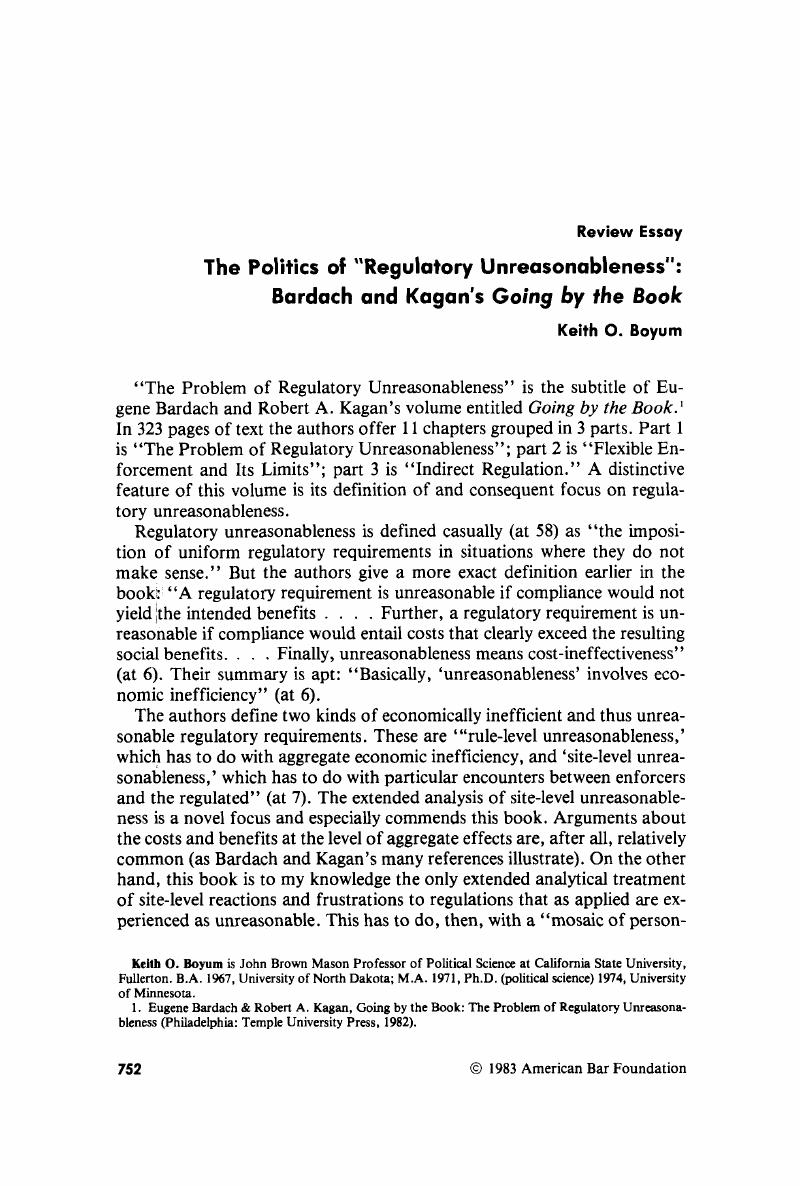No CrossRef data available.
Article contents
The Politics of “Regulatory Unreasonableness”: Bardach and Kagan's Going by the Book
Published online by Cambridge University Press: 20 November 2018
Abstract

- Type
- Review Essay
- Information
- Copyright
- Copyright © American Bar Foundation, 1983
References
1 Eugene Bardach & Robert A. Kagan, Going by the Book: The Problem of Regulatory Unreasonableness (Philadelphia: Temple University Press, 1982).Google Scholar
2 Kelman, Steven, Cost-Benefit Analysis: An Ethical Critique, 5 Regulation 33, 35 (1981).Google Scholar
3 Id. at 35–36.Google Scholar
4 Arthur M. Okun, Equality and Efficiency: The Big Tradeoff 13 (Washington, D.C.: Brookings Institution, 1975).Google Scholar
5 Kelman, supra note 2, at 36.Google Scholar
6 Compare Bruce A. Ackerman, Social Justice in the Liberal State 212–17 (New Haven, Conn.: Yale University Press, 1980).Google Scholar
7 Guido Calabresi, A Common Law for the Age of Statutes 173–74 (Cambridge: Harvard University Press, 1982).Google Scholar
8 William L. Hays, Statistics for Psychologists 280–81 (New York: Holt, Rinehart & Winston, 1963).Google Scholar
9 Reagan, Michael D., The Politics of Regulatory Reform, 36 W. Pol. Q. 149, 163 (1983).Google Scholar
10 Samuels, Warren J. & Shaffer, James D., Deregulation: The Principal Inconclusive Arguments, 1 Pol'y Stud. Rev. 463, 467 (1982).Google Scholar
11 Mass opinion is generally opposed to greater government intervention in the marketplace: see The Gallup Report, No. 193 (Oct. 1981); but compare substantial rates of mass public approval of regulation of barbiturates, of advertiser honesty, of prescription drug safety, of oil and gas prices, of bank interest rates, and of automobile safety in a February 1982 survey by the Roper Organization published in 5 Pub. Opinion 23 (1982). Different mass public reactions to abstractions (like “greater government intervention”) vs. particulars (e.g., prescription drug safety) is well known. Compare Samuel Krislov, The Supreme Court and Political Freedom ch. 1 (New York: Free Press, 1%8).Google Scholar
12 See Mnookin, Robert H. & Komhauser, Lewis, Bargaining in the Shadow of the Law: The Case of Divorce, 88 Yale L. Rev. 950 (1979); compare Marc Galanter, The Radiating Effects of Courts, in Keith O. Boyum & Lynn Mather, eds., Empirical Theories About Courts 115 (New York: Longman, 1982).Google Scholar




